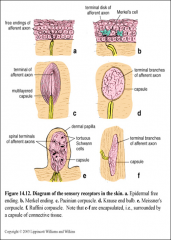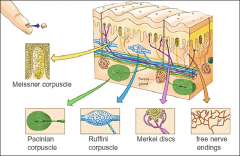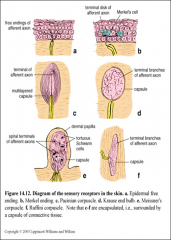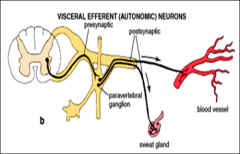![]()
![]()
![]()
Use LEFT and RIGHT arrow keys to navigate between flashcards;
Use UP and DOWN arrow keys to flip the card;
H to show hint;
A reads text to speech;
55 Cards in this Set
- Front
- Back
- 3rd side (hint)
|
.Dermis layer s
|
papillary layer is composed of loose connective tissue made up of very fine bundles of collagen, reticular and elastic fibers woven into a loose network.
|
|
|
|
Dermis
The fibers are surrounded by a gel of |
glycosaminoglycans
glycoproteins |
|
|
|
.enlarging uterus. The resultant scars show through the epidermis as white streaks known as the
|
striae gravidarum.
|
|
|
|
small bundles in connection with hair follicles =
|
(arrector pili)
|
|
|
|
cutis laxa
|
(skin becomes inelastic and hangs loosely in folds)
|
|
|
|
(skin becomes inelastic and hangs loosely in folds) called =
|
cutis laxa
|
|
|
|
Ehlers–Danlos syndromes,
|
considerable increase in skin and ligament extensibility caused by defective collagen-fibril processing.considerable increase in skin and ligament extensibility caused by defective collagen-fibril processing.
|
|
|
|
considerable increase in skin and ligament extensibility caused by defective collagen-fibril processing.considerable increase in skin and ligament extensibility caused by defective collagen-fibril processing.
called = |
Ehlers–Danlos syndromes,
|
|
|
|
Hypodermis
subcutaneous layer (superficial fascia) |
subcutaneous layer (superficial fascia)
|
|
|
|
In the eyelid, penis and scrotum, the subcutaneous layer is devoid of
|
fat
|
|
|
|
tissue of the hypodermis
|
insulates the body,
serves as a reserve energy supply, cushions and protects the skin. |
|
|
|
Blood supply
cutaneous plexus |
At the boundary between the papillary and reticular layer they form the denser,
|
subpapillary network (papillary plexus).
|
|
|
Arteriovenous Anastomoses
|
Direct channels between arterial and venous circulation
|
|
|
|
The lymphatics begin in the ________ as endothelium-lined clefts, which pass to a horizontal network of lymph capillaries in the papillary layer.
|
papillae
|
|
|
|
This network communicates with a second plexus just deeper than the first and via this with a third plexus at the junction of the dermis with the hypodermis.
|
.
|
|
|
|
sensory fibers alone (free nerve endings) or in conjunction with specialized structures (corpuscular receptors) function as sensory receptors of touch, pain, temperature, itch, and mechanical stimuli at every point of the body.
|

|
|
|
|
Meissner’s (Touch) Corpuscles
|
myelinated and nonmyelinated fibers terminate.
Structure: They are elongated ovoids which taper at each end. |
|
|
|
Pacinian (Lamellated) corpuscles:
|
clefts between flattened cells contain fluid under some pressure- and this makes the corpuscles turgid.
They are sensitive to pressure, movement vibration and stretch. |

|
|

Free Nerve endings
Ruffini corpuscle Krause end bulb |

|
|
|
|
Ano means
|
grow
|
|
|

Sympathetic motor fibers are codistributed with the sensory nerves in the dermis until they branch to innervate the =
3ct |
sweat glands
smooth muscle of vessels the arrector pili muscle. |
|
|
|
The nerves of the skin are large,
|
myelinated
cutaneous branches of musculocutaneous nerves which arise segmentally from spinal nerves. |
|
|
|
Types of hairs
first hair to be produced by the fetal follicles, called _______ is fine, soft, unmedullated and usually unpigmented. |
lanugo means =
Lanugo is normally shed in _____ when = |
(=wool)
utero seventh or eighth month of gestation. |
|
|
Postnatal hair can be divided into
|
Postnatal hair
terminal hair |
vellus
unmedullated unpigmented medullated and pigmented. |
|
|
Hairs do not grow continuously
Follicles progress synchronously to the destructive A resting phase = shed hair is called _____ hair = |
(catagen) phase
telogen (At this stage, the hair falls out or is pulled out) club hair because of the shape of its root. |
|
|
|
After a period of rest a new hair grows to replace the old one, and the hair growth cycle is repeated.
|
The life span of a single hair varies in different parts of the body, being as long as 4 years in the scalp and as short as 4 months in the axilla.
|
Hair growth of certain region of the body such as scalp, face and pubis, is strongly influenced by sex hormones (androgen).
|
|
|
Viewed from above a crescent-shaped light area is seen near the root of the nail. This is the ______ . It is a reflection of the partially keratinized cells in this region of the nail.
|
lunula
The edge of the skin fold covering the root of the nail is called the ___________ , or the cuticle. epidermal thickening which joins to the free edge of the nail plate on its undersurface is ____________. |
eponychium
hyponychium |
|
|
Glands of the skin include
|
sebaceous
sweat mammary glands |
|
|
|
Sebaceous glands are found on all areas of the skin with the exception of the palm, soles and dorsa of the feet.
|
palm,
soles dorsa of the feet. |
|
|
|
Hair free sebaceous glands are found in the mucous membranes of
|
oral cavity
labia minora internal fold of the prepuce (Tyson’s glands) eyelids (Meibomian glands & Zeis glands). |
|
|
|
The largest glands are usually found on the
|
face and scalp.
|
|
|
|
Sebaceous glands describe =
duct is lined by = located in the = |
stratified squamous
dermis _______ branched alveolar (__________) glands which synthesize ______. |
simple
saccular lipid |
|
|
Sebaceous glands how they work =
|
central cell degenerate
(holocrine secretion) mitosis to the secretion of sebum takes about _ days |
8d
|
|
|
Sebaceous glands
arrector pili muscle assists the gland in = |
discharging its contents.
|
|
|
|
Sebaceous glands contains =
Puberty Increased Androgens Increased Sebum secretion |
sebum
sebum contains = |
triglycerides
fatty acids wax ester, |
|
|
Acne vulgaris
when = Increased = Increased = |
Puberty
Androgens Sebum secretion |
|
|
|
Sweat glands are of two types
|
ordinary sweat glands = aka
odoriferous sweat glands. = aka |
(eccrine)
(apocrine) |
|
|
Sweat glands are of two types
tech Nm = |
(eccrine) =
(apocrine) = |
ordinary sweat glands = aka
odoriferous sweat glands. = aka |
|
|
odoriferous sweat glands. = aka
ordinary sweat glands = aka |
(apocrine) =
(eccrine) = |
|
|
|
ordinary sweat glands are small compared to =
|
(apocrine) = aka
|
odoriferous
|
|
|
Ordinary sweat glands = aka
The duct of the sweat glands consists of = |
eccrine
stratified cuboidal |
|
|
|
eccrine sweat glands produce a
|
watery solution
low in protein containing varying amounts’ of sodium chloride, urea, uric acid ammonia. |
|
|
|
Eccrine sweat glands are innervated by =
|
postganglionic cholinergic sympathetic fibers.
|
|
|
|
Ordinary sweat glands
What increases the activity of the sympathetic nerves = |
increase in the temperature of the blood circulating through the hypothalamus
|
|
|
|
excess heat causes sweating to begin on the =
|
forehead
then spread down over body |
|
|
|
weating caused by emotional and mental stimuli starts on the =
|
palms and soles and in the axillae
stimulated by = |
adrenergic portion of
sympathetic |
|
|
Apocrine sweat gland
odoriferous (apocrine) sweat glands are located in = |
axilla
nipples scrotum labia major pubic perineal and circumanal regions |
|
|
|
T/F
Apocrine sweat glands are larger than the ordinary sweat glands |
True
|
|
|
|
Apocrine sweat gland
is odorless, bacterial decomposition is responsible for the musky acrid odor. |
.
|
|
|
|
Apocrine sweat gland
|
secretion is produced continuously and is not concerned with thermoregulation.
Apocrine glands start to function at puberty and are under the control of the sex hormones. + |
In the females, both axillary and areolar apocrine glands undergo morphological and secretory changes that parallel the menstrual cycle.
|
|
|
Modified apocrine sweat gland
|
ciliary glands (glands of Moll)
|
|
|
|
Modified apocrine sweat gland
|
ceruminous glands are also modified apocrine glands
external auditory meatus ceruminous glands secrete ear wax. |
|
|
|
ceruminous glands secrete
|
ear wax
they are what type of gland = |
Modified apocrine sweat gland
|
|
|
ear wax made by what glands =
|
ceruminous glands
they are what type of gland = |
Modified apocrine sweat gland
|
|
|
glands of Moll = aka
|
ciliary glands
are found at the margins of the |
eyelids
and open into or near the orifices of the eyelash follicles. |

